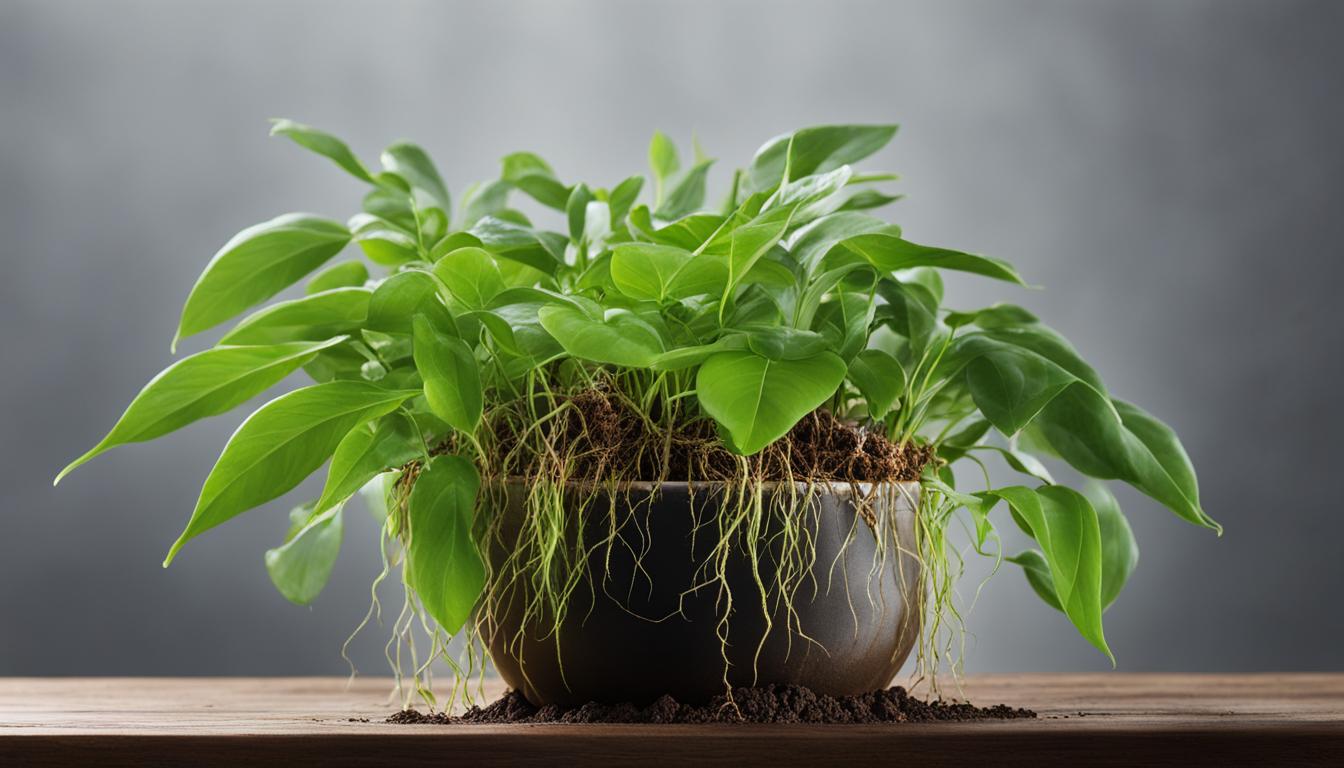Gardening brings joy and beauty to our lives, but sometimes our well-intentioned actions can inadvertently harm our plants. One of the most common issues that gardeners face is root rot, often caused by overwatering. As an avid plant lover myself, I understand the frustration of seeing our precious greens suffer. Fortunately, there are steps we can take to save our plants from drowning and prevent root rot.
Root rot is a fungal disease that affects the roots of our plants, hindering their ability to absorb essential nutrients and water. Overwatering is a primary culprit that leads to this condition. When our plants receive excess moisture, the roots become waterlogged, oxygen is deprived, and stress sets in. This weakened state makes them more susceptible to diseases such as root rot.
To keep our plants thriving, it’s crucial to understand the effects of overwatering on their roots. Healthy roots act as the lifeline of our plants, supplying them with water, nutrients, and oxygen. Unfortunately, when roots are drowned, they struggle to function properly, compromising overall plant health.
Key Takeaways
- Overwatering is the main cause of root rot, a fungal disease that affects plant roots.
- Healthy roots are essential for plant health as they absorb nutrients, water, and oxygen.
- Signs of overwatering include wet soil, light green foliage, wilting, and mold or fungus growth.
- To rescue overwatered plants, stop watering them and allow the soil to dry out. Improve drainage and repot the plant if necessary.
- Treating root rot involves removing damaged roots and using fungicides. Repotting in a well-draining soil mix can help prevent further root rot.
Understanding the Effects of Overwatering on Plant Roots
Healthy roots are essential for the overall well-being of plants. They play a crucial role in absorbing water, nutrients, and oxygen, which are vital for their growth and development. However, overwatering can have detrimental effects on plant roots and compromise their health.
When plants are overwatered, the excess moisture in the soil prevents the roots from accessing the oxygen they need to survive. This lack of oxygen can lead to stress in the plant, making it more susceptible to diseases such as root rot.
“Overwatering can drown plant roots and deprive them of oxygen, causing stress and making them more susceptible to diseases like root rot.”
Root rot occurs when the roots are continuously exposed to excessive moisture, creating the perfect environment for fungal pathogens to thrive. These pathogens attack the roots, causing them to rot and lose their ability to function properly. As a result, the plant’s overall health deteriorates, and it may eventually die if left untreated.
“Root rot is a common consequence of overwatering, as it creates favorable conditions for fungal pathogens that attack and damage the roots.”
To better understand the effects of overwatering on plant roots, let’s take a closer look at the process:
- Excessive watering saturates the soil, leaving no room for air pockets to form. This prevents vital oxygen from reaching the roots.
- The lack of oxygen in the root zone causes the roots to become stressed and unable to perform their essential functions effectively.
- The stressed roots become more vulnerable to pathogens, particularly those that thrive in waterlogged conditions.
- Fungal pathogens invade the weakened roots, leading to the development of root rot.
- The damaged roots are no longer able to absorb nutrients and water efficiently, resulting in further stress and decline of the plant’s overall health.
| Effects of Overwatering on Plant Roots | Consequences |
|---|---|
| Lack of oxygen | Roots become stressed and less capable of performing their functions. |
| Increased vulnerability to pathogens | Roots are more prone to fungal infections, leading to root rot. |
| Impaired nutrient and water absorption | Roots lose their efficiency in absorbing essential resources, resulting in further stress and decline of the plant. |
Understanding the detrimental effects of overwatering on plant roots highlights the importance of proper watering practices in maintaining plant health. By avoiding excessive watering and ensuring a well-draining soil, you can protect your plants from the stress and potential damage caused by root rot.
What is Root Rot and How Does it Affect Plants?
Root rot is a fungal disease that can have devastating effects on plant health. It predominantly affects the roots of plants, leading to a range of symptoms and ultimately, plant decline or death. Understanding the causes, symptoms, and fungal culprits behind root rot is essential for effectively managing and preventing this common plant problem.
The main causes of root rot are various fungi that thrive in damp, poorly drained soil conditions. The most common fungal culprits responsible for root rot include Pythium, Phytopthera, and Rhizoctonia. These fungi invade the roots, causing them to decay and lose their functionality.
The symptoms of root rot are often indicative of the damage occurring beneath the soil surface. Initially, affected plants may exhibit general signs of decline, such as stunted growth and yellowing foliage. As the disease progresses, the roots may turn brown, grey, or black, become slimy or mushy in texture, or even deteriorate entirely. Infected roots are less capable of absorbing water and nutrients, leading to wilting, withering leaves, and overall plant weakness.
Overwatering is a significant contributing factor to the development of root rot. When plants are consistently overwatered, the excess moisture creates an ideal environment for the growth and spread of root-rot-causing fungi. Additionally, overwatering can lead to poor soil oxygenation, further weakening the roots and exacerbating the root rot problem.
The Fungal Culprits of Root Rot
| Fungi | Description |
|---|---|
| Pythium | A water mold that thrives in waterlogged soil, attacking the roots and causing damping-off in young plants. |
| Phytopthera | A soil-borne fungi that causes various diseases, including root rot, particularly in wet and cool environments. |
| Rhizoctonia | A fungus commonly found in soil, responsible for causing damping-off, root rot, and other diseases in plants. |
Identifying the specific fungal culprits behind root rot can help in choosing appropriate treatment methods and preventive measures. A systematic understanding of root rot causes, symptoms, and the key fungi involved is crucial for safeguarding the health and vitality of your plants.
Signs and Symptoms of Overwatering
Overwatering can have detrimental effects on your plants, and it’s important to recognize the signs before it’s too late. Here are some key indicators to watch out for:
- Yellowing Leaves: One of the first signs of overwatering is yellowing leaves. When plants receive too much water, the roots become waterlogged, hindering their ability to absorb nutrients. This leads to a lack of chlorophyll production, resulting in yellow or brown foliage.
- Wilting: Surprisingly, wilting can be a sign of both under and overwatering. However, if your plant’s soil is consistently wet and the leaves are droopy rather than dry and crispy, it’s likely due to overwatering. The excess moisture causes the roots to suffocate and impairs their ability to supply water to the rest of the plant.
- Mold and Fungus Growth: Mold and fungus thrive in damp environments, making them common indicators of overwatering. Keep an eye out for white, fuzzy growth on the leaves and stems, as well as mold or fungus developing on the soil’s surface. These fungi deprive the plant of oxygen and can lead to further damage if left unchecked.
- Constantly Damp Soil: If the soil around your plant remains consistently wet, even days after watering, it’s a clear sign of overwatering. Healthy plant roots need a balanced supply of air and water, and excess moisture disrupts this delicate balance, resulting in suffocated roots.
If you notice one or more of these symptoms, it’s crucial to take action to prevent further damage to your plants.
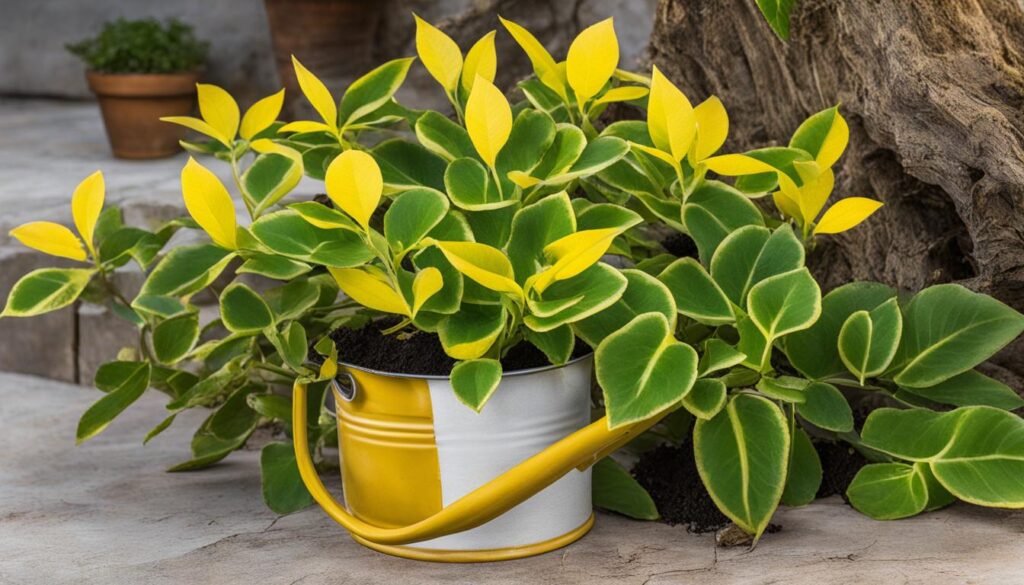
Fixing Overwatered Plants
So you’ve identified that your plants have been overwatered, and now you’re wondering how to fix the problem. Don’t worry, I’ve got you covered! The first step is to stop watering your plants immediately and allow the soil to dry out. This will help prevent further damage to the roots caused by excess moisture.
Next, it’s important to improve the drainage of your plants. One way to do this is by ensuring that the pot or container you’re using has proper drainage holes. These holes allow excess water to escape, preventing water from accumulating in the soil and causing root problems. Alternatively, if your current pot doesn’t have drainage holes, consider repotting your plant into a new pot that provides proper drainage.
Repotting your plant can also provide fresh soil, which is beneficial for its overall health and growth. When repotting, choose a pot that is slightly larger than the current one and use a well-draining soil mix. This will allow water to flow freely through the soil and prevent waterlogging, reducing the risk of overwatering.
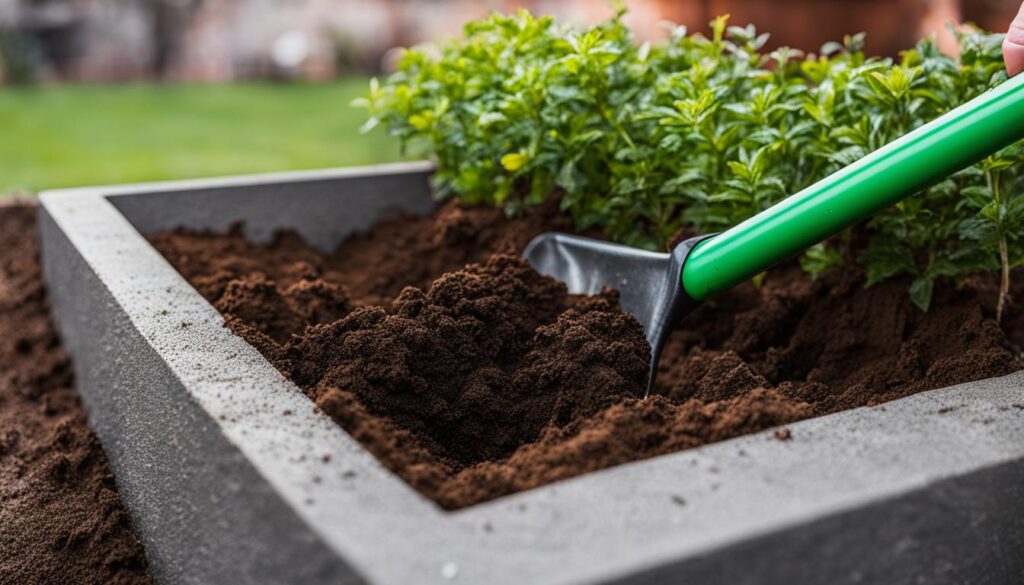
Key Steps to Fix Overwatered Plants:
- Stop watering your plants and allow the soil to dry out.
- Ensure the pot has proper drainage holes or consider repotting into a pot that provides drainage.
- Use a well-draining soil mix when repotting for better water flow.
“By following these steps, you can help your overwatered plants recover and prevent future overwatering issues.”
Remember, prevention is always better than cure when it comes to plant care. By taking the necessary steps to stop watering, improve drainage, and repot your overwatered plants, you’ll be well on your way to ensuring their long-term health and vitality.
Treating Root Rot
If the plant has developed root rot, it is important to take immediate action to prevent further damage. Treating root rot involves:
- Removing damaged roots: Carefully inspect the plant’s roots and identify any affected areas. Use clean scissors or pruning shears to trim away the damaged roots. Be sure to remove all the affected portions without causing further harm to the plant.
- Treating with a fungicide: Once the damaged roots have been removed, it is crucial to treat the remaining healthy roots with a suitable fungicide. This will help eliminate the fungal pathogens responsible for root rot. Follow the instructions on the fungicide label and apply it according to the recommended dosage.
- Repotting in well-draining soil mix: After treating the roots, repot the plant in a fresh, well-draining soil mix. This will provide the plant with optimal conditions for root regeneration and prevent the recurrence of root rot. Ensure the new pot has proper drainage to prevent excess moisture accumulation.
Fungicides for Root Rot Treatment
| Fungicide | Description | Application |
|---|---|---|
| Fungicide A | A broad-spectrum fungicide effective against various fungal pathogens. | Apply as a soil drench or foliar spray according to the manufacturer’s instructions. |
| Fungicide B | Specifically formulated to target root rot-causing fungi. | Apply directly to the roots or as a soil treatment. |
| Fungicide C | An organic fungicide suitable for eco-friendly gardening. | Apply as a soil drench or foliar spray at regular intervals. |
It is essential to closely monitor the plant’s progress after treating root rot. Ensure the plant receives appropriate watering and care to aid in its recovery. By promptly addressing root rot and providing the necessary treatment, you can increase the chances of saving your plant and restoring its health.
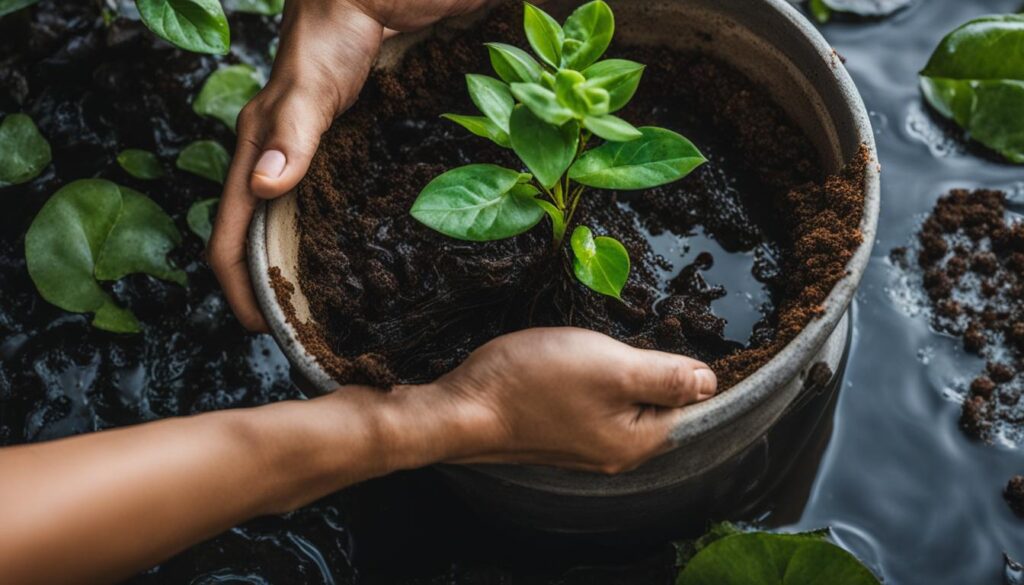
Preventing Overwatering and Root Rot
To prevent overwatering and root rot, I recommend following proper watering techniques, using a well-draining soil mix, and ensuring pots have drainage holes.
First and foremost, it’s important to water your plants only when the soil is dry to the touch. Overwatering can suffocate the roots and facilitate the development of root rot. By allowing the soil to dry out between waterings, you’ll give the roots the opportunity to breathe and absorb nutrients properly.
Next, consider the type of soil mix you’re using. A well-draining soil mix allows excess water to flow out of the pot, preventing water from accumulating around the roots. Opt for a mix that contains organic matter like perlite or vermiculite, as these materials help improve drainage.
Furthermore, make sure your pots have drainage holes. These holes allow excess water to drain out, preventing water from pooling at the bottom of the pot. If your favorite decorative pot doesn’t have drainage holes, you can place a layer of rocks or pebbles at the bottom to create a reservoir for excess water.
Remember, prevention is key. By following these proper watering techniques, using a well-draining soil mix, and ensuring pots have drainage holes, you can greatly minimize the risk of overwatering and root rot.
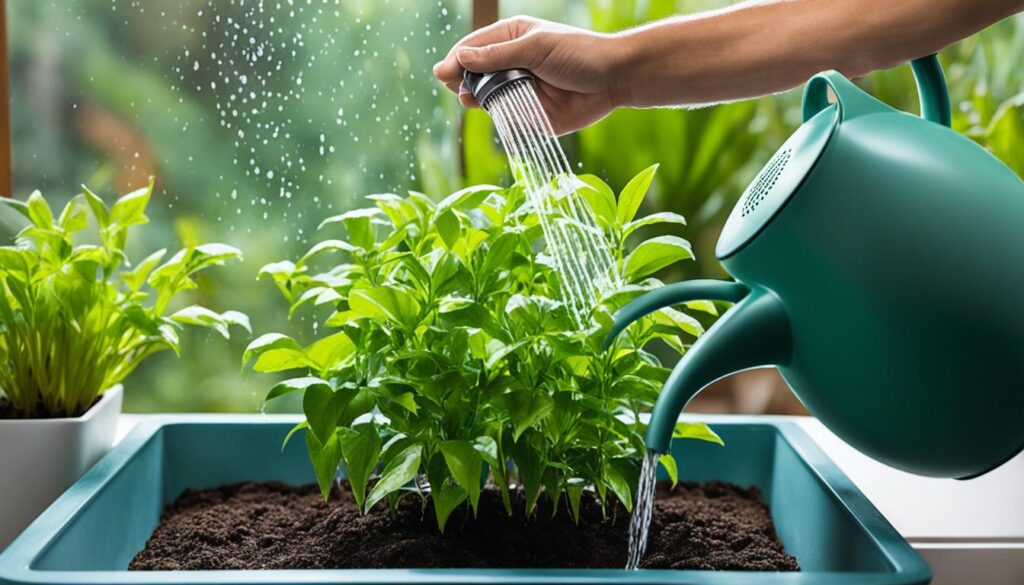
With proper watering techniques and good soil drainage, your plants will thrive, and you’ll be able to enjoy their beauty for years to come.
Signs of Healthy Plants and Preventive Measures
To ensure the well-being of your plants, it is essential to be aware of the signs of a healthy plant and implement preventive measures. By understanding these indicators, you can establish a watering barometer and develop an appropriate watering schedule to prevent overwatering and maintain optimal plant health.
Here are some signs to look for:
- New Growth: Healthy plants exhibit new growth in the form of vibrant leaves, shoots, or blossoms. This indicates that the plant is thriving and receiving adequate nutrients.
- White Roots: When inspecting the roots of your plant, healthy roots appear white and firm. White roots indicate a well-established and nourished root system.
- Moist, not Wet Soil: Maintaining the right moisture level in the soil is crucial. When checking the soil, it should be moist to the touch but not soaking wet. This ensures that the plant receives enough hydration without risking root rot.
Monitoring soil moisture is crucial in determining the appropriate watering schedule. You can use a moisture meter for accurate readings or simply check if the soil is dry to the touch. Adjusting the watering schedule based on the plant’s needs and environmental conditions is key to preventing overwatering.
“By paying attention to these signs, I can ensure that my plants stay healthy and thriving. Regularly monitoring soil moisture and adjusting my watering schedule accordingly has made a significant difference in the well-being of my plants.”
Implementing preventive measures is equally important in maintaining healthy plants:
- Proper Drainage: Ensure that your pots have adequate drainage holes to allow excess water to escape. If your pot does not have drainage holes, consider double potting the plant to prevent water accumulation.
- Well-Draining Soil Mix: Use a high-quality, well-draining soil mix that allows water to flow freely through the pot. This helps prevent waterlogging and allows the roots to access the necessary oxygen.
- Additional Accessories: Adding accessories like lava rocks or perlite to the soil mix can improve drainage and prevent overwatering.
By paying attention to the signs of healthy plants and implementing preventive measures, you can foster optimal plant growth and prevent the risks associated with overwatering and root rot.
Tips to Avoid Overwatering
Overwatering can be detrimental to plant health and lead to issues like root rot. To prevent overwatering and promote the well-being of your plants, consider implementing the following tips:
- Checking Soil Moisture: Periodically assess the moisture content of the soil by inserting your finger an inch or two into the soil. If it feels moist, avoid watering until the top inch becomes slightly dry. This method helps ensure that you’re only watering when necessary and preventing overhydration.
- Evaluating Weight: Lift the pot to evaluate its weight. If it feels heavy, it is a sign that the soil is still adequately moist, and you can hold off on watering. On the other hand, a lightweight pot may indicate the need for watering. By gauging the weight, you can avoid the common mistake of overwatering caused by a fixed watering schedule.
- Proper Drainage: Ensure that the pots you use for your plants have proper drainage holes. These holes allow excess water to escape, preventing waterlogged soil and stagnant moisture that can lead to root rot. If your pot does not have drainage holes, consider using a double-potting method or drill holes at the bottom.
- Well-Draining Soil Mix: Opt for a well-draining soil mix when potting your plants. These mixes typically contain ingredients like perlite, vermiculite, or coarse sand, which promote proper drainage. Well-draining soil prevents water from accumulating around the roots and reduces the risk of overwatering.
- Using Accessories: Adding accessories like lava rocks or pebbles at the bottom of the pot can help improve drainage. These materials create a layer between the soil and the drainage holes, facilitating water flow while preventing the roots from sitting in excess moisture.
By following these tips, you can effectively avoid overwatering your plants, maintain proper soil moisture levels, and create an environment that fosters healthy root growth.
| Tips to Avoid Overwatering | Benefits |
|---|---|
| Checking Soil Moisture | Prevents overhydration and watering when necessary |
| Evaluating Weight | Helps determine watering needs based on soil moisture |
| Proper Drainage | Prevents waterlogged soil and root rot |
| Well-Draining Soil Mix | Facilitates water drainage and reduces overwatering risks |
| Using Accessories | Improves drainage without compromising root health |
Conclusion
Rescuing overwatered plants and preventing root rot are essential for maintaining the health of your beloved greenery. By implementing proper watering techniques, improving drainage, and promptly treating root rot, you can save your plants from drowning and ensure their longevity.
Regular monitoring of plant health is crucial in preventing overwatering and catching signs of root rot early on. Adjusting watering schedules based on the plant’s needs and the surrounding environment is key. Remember to check the soil moisture by evaluating its dryness with your finger or using a moisture meter.
In addition to proper watering, improving drainage is vital for preventing overwatering and root rot. Ensure that your pots have sufficient drainage holes or consider double potting your plants. Opting for a well-draining soil mix and incorporating accessories like lava rocks can also enhance drainage.
Rescuing overwatered plants and preventing root rot require diligence and attention to detail. By following these guidelines and incorporating them into your plant care routine, your green companions will thrive and bring beauty to your space for years to come.
FAQ
What is the most common cause of early plant death?
Overwatering is the most common cause of early plant death.
How does overwatering affect plant roots?
Overwatering can drown plant roots and deprive them of oxygen, leading to stress and susceptibility to diseases like root rot.
What is root rot and how does it affect plants?
Root rot is a fungal disease that affects plant roots, causing them to become brown, grey, black, slimy, or non-existent. It is often caused by overwatering and can impede nutrient and water absorption.
What are the signs and symptoms of overwatering?
Signs of overwatering include yellow or brown leaves, wilting even when the soil is wet, mold and fungus growth on the plant and in the soil, and constantly damp soil.
How can I fix overwatered plants?
To fix overwatered plants, you should stop watering them and allow the soil to dry out. You can also improve drainage by ensuring the pot has proper drainage holes or repotting the plant into a pot with better drainage.
How do I treat root rot?
Treating root rot involves removing the damaged roots and treating them with a fungicide. Repotting the plant in a well-draining soil mix can also help prevent further root rot.
How can I prevent overwatering and root rot?
To prevent overwatering and root rot, follow proper watering techniques such as watering only when the soil is dry to the touch. Ensuring pots have drainage holes and using a well-draining soil mix can also help prevent overwatering and root rot.
What are the signs of healthy plants and how can I maintain them?
Signs of healthy plants include new growth, white roots, and moist but not wet soil. Monitor the soil moisture and adjust watering schedules based on the plant’s needs and environmental conditions.
How can I avoid overwatering?
Avoid overwatering by checking the soil moisture with your finger or evaluating the weight of the pot. Use pots with proper drainage holes or double pot the plant. Using a well-draining soil mix and adding accessories like lava rocks can also help prevent overwatering.
How can I save my plants from drowning and prevent root rot?
By following proper watering techniques, improving drainage, and promptly treating root rot, you can save and prevent your plants from drowning. Regularly monitor plant health and adjust watering schedules accordingly.

